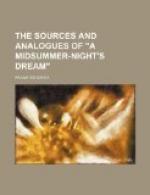Minor allusions, chiefly, to Robin Goodfellow, he may have met with in various works[45] published before the assumed date of the play; but these, again, add nothing which Shakespeare could not have learned just as well from the superstitions of his day. What these were, and how he handled them, we must now proceed to discuss.
In approaching a subject such as fairy-lore, it is necessary to prepare the mind of the reader to go back to days not merely pre-Christian but even pre-national. Our fairies can no more justly be called English than can our popular poetry. Folk-lore—the study of the traditional beliefs and customs of the common people—is a science invented centuries too late;[46] for lack of evidence, it is largely theoretical. But it teaches its students continually to look further afield, and to compare the tales, ballads, superstitions, rites, and mythologies of one country with those of another. The surprising results thus obtained must not make us think that one country has borrowed from another; we must throw our minds back to a common ancestry and common creeds. “The attempt to discriminate modern national characteristics in the older stratum of European folk-lore is not only idle but mischievous, because it is based upon the unscientific assumption that existing differences, which are the outcome of comparatively recent historical conditions, have always existed.” These are the wise words of a sound folk-lorist,[47] and should be laid to heart by all who take up the study.
We cannot begin to investigate the origins of the fairy superstition in the cradle of the world; we must be content to realise that there was a creed concerning supernatural beings common to all the European branches of the Aryan peoples, Greek, Roman, Celt or Teuton. When Thomas Nashe wrote in 1594 of “the Robbin-good-fellowes, Elfes, Fairies, Hobgoblins of our latter age, which idolatrous former daies and the fantasticall world of Greece ycleaped Fawnes, Satyres, Dryades, and Hamadryades,” he spoke more truly than he knew.[48]
First of all, let us consider the word fairy. Strictly, this is a substantive meaning either “the land of the fays,” or else “the fay-people” collectively; it is also used as an equivalent for “enchantment.” It was originally, therefore, incorrect to speak of “a fairy";[49] the singular term is “a fay,” as opposed to “the fairy.” Fay is derived, through French, from the Low Latin fata, misunderstood as a feminine singular; it is in fact the plural of Fatum, and means “the Fates.”
Reversing the chronological order, let us proceed to compare the functions of these beings. The Fates, whether the Greek Moirae or the Roman Parcae, were three in number, and were variously conceived as goddesses of birth or of death; the elements of the primitive idea are, at least, comprised in the conception that they allotted man his fate; we may also note that the metaphor of spinning was used in connection with their duties.




